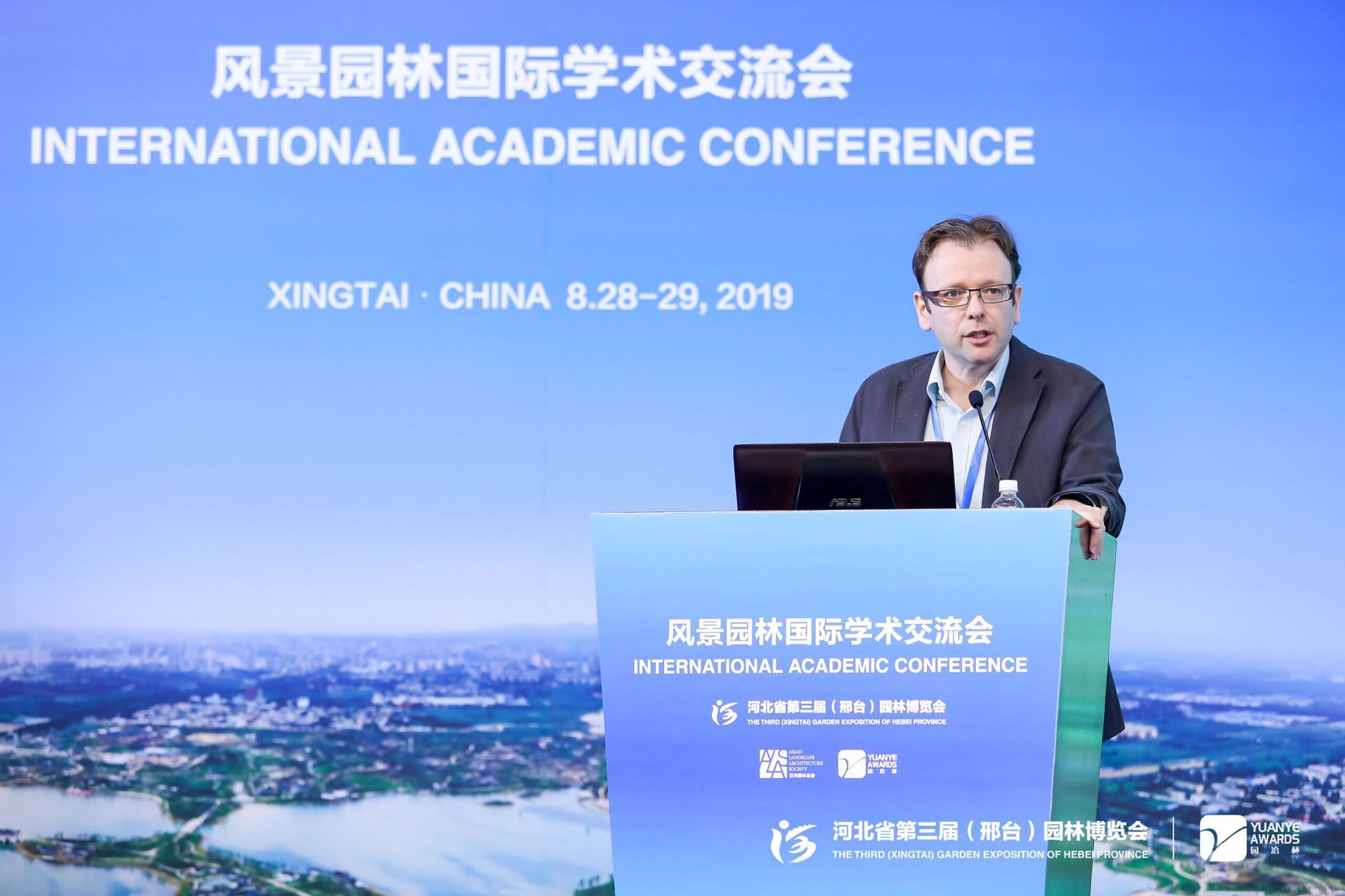

12th Sept 2019
‘Landscape architecture needs to be guided by user experience’ says Grant Associates
Stefaan Lambreghts, Associate Director at Grant Associates, has delivered a keynote speech about the need for landscape architecture to create spaces where people can more fully experience the wonder of nature.
Speaking at an international expo in Hebei Province, northern China, Stefaan argued that the best landscape design concepts were guided by ‘user experience’ rather than being a vehicle for artistic self-expression.
Stefaan was among a line-up of industry experts and academics to present at the Third Garden Expo / International Academic Conference on Landscape Architecture, which was held in the city of Xingtai (28 August – 2 September 2019). The event explored the theme of how to improve city life for people by integrating green space into the fabric of urban environments.
Within his talk ‘Fusing landscape engineering with experience’, Stefaan drew on a range of Grant Associates’ projects to illustrate the practice’s approach.
Project case studies included:
Robinson Tower. This recently completed, mixed-use scheme in the Central Business District of Singapore features a series of stepped and planted roof terraces within the 20-storey tower. Working with architects Kohn Pederson Fox and A61 Architects on the scheme, Grant Associates’ aim was to give building users a dramatic experience of nature despite being in a high-rise building.
Sino Singapore Friendship Park. A 41-hectare city park in Tianjin Eco-City, northern China, Grant Associates’ design team placed themselves ‘in the shoes’ of visitors, creating a diversity of spaces that offer shelter, drama, respite and intrigue.
Gardens by the Bay (Cloud Forest). Grant Associates’ masterplan for Singapore’s internationally acclaimed visitor destination includes a giant biosphere housing a tropical rainforest. It was designed to give visitors an immersive, multi-sensory experience of nature, from the sound of its waterfalls to the feel of its humidity and the sight of its lush greenery.
Other keynote presenters at the expo, which was held at Xingtai Wanfeng Hotel and attracted over 600 delegates, included Dong Xiaoyu, Mayor of Xingtai City; Fumiaki Takano of Takano Landscape Planning; Liu Xiuchen, Director at Arup; Justin Abbott, Director of the United Nations Environment Programme; and Qiang Jian, Vice Chairperson of the Chinese Society of Landscape Architecture.
Stefaan Lambreghts comments: “There’s growing momentum in China to create cities that offer people a better quality of life. Integrating green space into urban environments is an important part of the solution. But simply adding greenery to cities is not enough – we need to consider the experience of the people in this space, and how we can fully capitalise on the power of nature to stir our imaginations, and enhance a sense of wellbeing.
“Projects like Sino Singapore Friendship Park in Tianjin Eco-City demonstrate that more imaginative models for urban planning are being implemented in China. It’s an exciting time for landscape architecture in this part of the world. It was a pleasure to take part in this expo and discuss how we can use landscape to help shape our future cities for the better.”
Speaking at an international expo in Hebei Province, northern China, Stefaan argued that the best landscape design concepts were guided by ‘user experience’ rather than being a vehicle for artistic self-expression.
Stefaan was among a line-up of industry experts and academics to present at the Third Garden Expo / International Academic Conference on Landscape Architecture, which was held in the city of Xingtai (28 August – 2 September 2019). The event explored the theme of how to improve city life for people by integrating green space into the fabric of urban environments.
Within his talk ‘Fusing landscape engineering with experience’, Stefaan drew on a range of Grant Associates’ projects to illustrate the practice’s approach.
Project case studies included:
Robinson Tower. This recently completed, mixed-use scheme in the Central Business District of Singapore features a series of stepped and planted roof terraces within the 20-storey tower. Working with architects Kohn Pederson Fox and A61 Architects on the scheme, Grant Associates’ aim was to give building users a dramatic experience of nature despite being in a high-rise building.
Sino Singapore Friendship Park. A 41-hectare city park in Tianjin Eco-City, northern China, Grant Associates’ design team placed themselves ‘in the shoes’ of visitors, creating a diversity of spaces that offer shelter, drama, respite and intrigue.
Gardens by the Bay (Cloud Forest). Grant Associates’ masterplan for Singapore’s internationally acclaimed visitor destination includes a giant biosphere housing a tropical rainforest. It was designed to give visitors an immersive, multi-sensory experience of nature, from the sound of its waterfalls to the feel of its humidity and the sight of its lush greenery.
Other keynote presenters at the expo, which was held at Xingtai Wanfeng Hotel and attracted over 600 delegates, included Dong Xiaoyu, Mayor of Xingtai City; Fumiaki Takano of Takano Landscape Planning; Liu Xiuchen, Director at Arup; Justin Abbott, Director of the United Nations Environment Programme; and Qiang Jian, Vice Chairperson of the Chinese Society of Landscape Architecture.
Stefaan Lambreghts comments: “There’s growing momentum in China to create cities that offer people a better quality of life. Integrating green space into urban environments is an important part of the solution. But simply adding greenery to cities is not enough – we need to consider the experience of the people in this space, and how we can fully capitalise on the power of nature to stir our imaginations, and enhance a sense of wellbeing.
“Projects like Sino Singapore Friendship Park in Tianjin Eco-City demonstrate that more imaginative models for urban planning are being implemented in China. It’s an exciting time for landscape architecture in this part of the world. It was a pleasure to take part in this expo and discuss how we can use landscape to help shape our future cities for the better.”